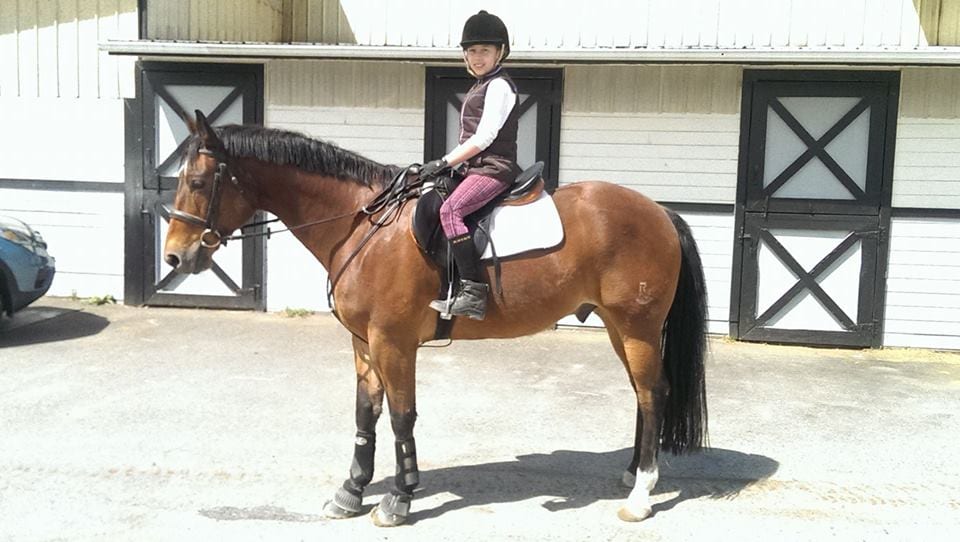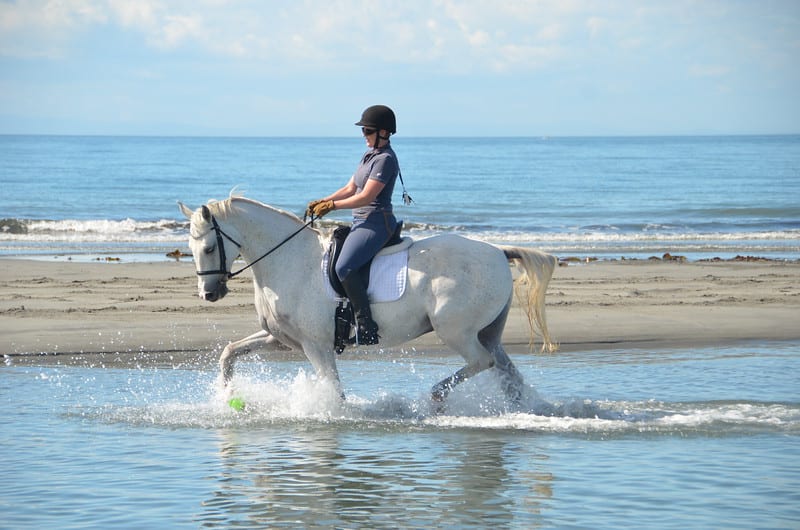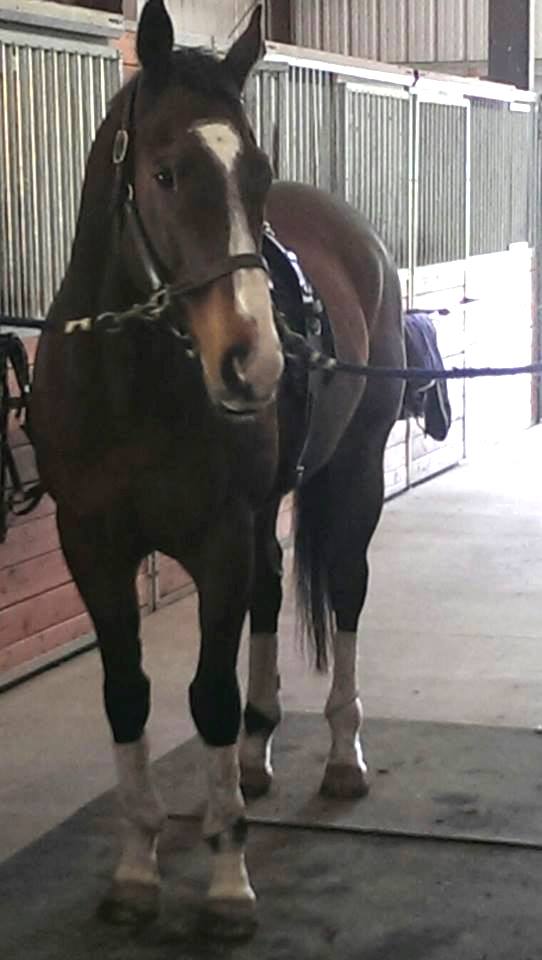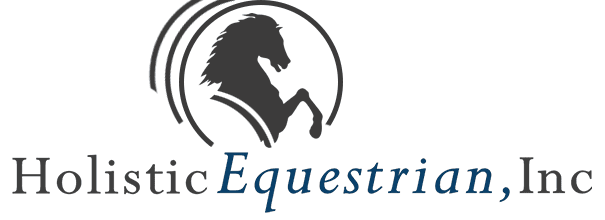
Whether your goal is FEI Dressage competition, 3-Day Eventing, or just hacking out on a horse that is comfortable and confident, the conditioning programs offered by Holistic Equestrian can help you and your horse get there.
Founder Tammy Prevo’s background includes both Jumping and Dressage, with a strong emphasis on making the horse physically comfortable, strong and capable of doing the work, and then letting them shine through their training in the sport of your choice.
If they aren’t addressed in the early training, the natural asymmetries of the horse can result in completely unnecessary lameness as the horse ages. Over-use can greatly shorten the timeline to repetitive strain injuries, which often end a horse’s riding career, or at the very least, competitive career. Holistic Equestrian can address these lamenesses, and bring the horse back to optimum function in many cases with our slow and methodical approach to supporting the body holistically in recovery and repair, including veterinary acupuncture and chiropractic to “reset” the structures, massage and body work to help improve the muscle tone, and then therapeutic exercises to strengthen, straighten, and develop a balanced athletic body to give the horse its best chance to support its own recovery.
Horses with injuries, horses that have inherent asymmetries that have become lameness, horses that aren’t living up to their potential, or horses whose owners simply would like to see them be “better” at their chosen sport can find great success through a Holistic Equestrian conditioning program.
We use a variety of training methodologies and tools to help the horse in this process, and customize the program for each horse’s individual needs. See what we can do for your horse, today.
Success Stories
Big Red
Six year old, 17.3hh Red came to us as a severely underweight and anxious boy. He is a Thoroughbred that raced rather unspectacularly, and then went on to do some lower level Eventing before being purchased by his current owners. Red not only had emotional baggage to unravel, but also had a very old and unusual injury whereby the tuber coxie of his right pelvis (also called the “point of the hip”) was quite literally missing. Instead of a rounded protrusion, that part of his hip was an indentation. Red also had a pretty significant vertebral shift in his upper neck that made bending right very difficult. Red was visibly uneven behind while trotting, and got very anxious when asked to work with a right bend. Red was also quite anxious about working in the arena, and would get very tense in anticipation of whatever his previous experiences were.
A good quality feeding program with plenty of high quality hay, beet pulp and rice bran took care of Red’s weight. However, without the ability to provide structural support in the form of chiropractic or other body work, we were able to not only strengthen Red’s entire body so that his gaits became more even, but also improve his neck issue. Red turned out to love hacking out, so initially most of his strengthening and conditioning work happened outside of the arena.
It’s important to note here that correct saddle fit was an extremely important part of Red’s re-conditioning. He is the type of horse would act out violently against pain, becoming dangerous when his saddle started to create pressure points near his withers. A better fitting saddle that evenly distributed the rider’s weight across the length of his back set Red up for success and allowed him to let go of some of his anxiety and anticipation of pain. With his foundation of strength and fitness, Red should be able to go on to comfortable do whatever job his owners wish him to.
Cindy & Rio
Prior to spending a year or so in pasture, 16 year old Rio was a children’s hunter for quite some time. In the summer of 2020, Cindy, Rio’s owner, pulled her out of the pasture and decided to do some dressage work with an eye towards possibly going to some shows. The challenge with Rio was to get her fit in a very short time without putting undue stress on her aging body, while at the same time almost completely changing how she used her body for balance and suppleness, AND stepping up Cindy’s game so that she could replicate at competition what she was learning at home.
With very deliberate and careful work with Tammy, Cindy managed to not only compete Rio in a couple of recognized shows with scores in the high 60s, but qualified her and went to Region 6 Regional championships, all within about 5 months.
The careful and deliberate process to getting Rio back in the ring was so successful that Cindy has decided to set her sights on competing at a higher level next year. I am confident that Rio will be able to make the move up with relative ease, because she is becoming stronger, more balanced, and more supple with the conditioning work. The more challenging work will come easily with that foundation.

Drambuie
Drambuie was a typical PMU foal, with Quarter Horse and Percheron and who knows what else in his ancestry. At easily 4 inches higher behind than at the withers, Drambuie didn’t have it all going for him, physically. The one thing he did have, though, was heart and the willingness to try no matter what. He started his career with 3-day eventing, working up to Preliminary level (3’7″ jumps and approx. 1st level Dressage with some 2nd level components). Drambuie came to Holistic Equestrian at age 16, after a suspensory injury and quite a lot of time off.
After nearly 8 months of just twice a week basic fitness work – light walk, trot and canter in the arena, Drambuie’s owner decided to put him into full training with Tammy. Within 5 weeks of varied conditioning work – cavaletti work, hill work, dressage training and long-reining – Drambuie’s entire body changed. He developed the strength and suppleness to begin half-passes, flying changes, working canter pirouettes and playing with piaffe half-steps. The foundation of the previous 8 month’s basic dressage work, even though it was only twice a week, allowed for a rapid building of strength and fitness once he was engaged fully in the work, and made this horse, whose forehand nature had decreed should stay firmly planted on the ground, light on his feet and able to dance!
Gato
As a 16 year old ex-reining Quarter Horse, Gato was semi-retired with long-term navicular pain. Corrective shoeing and periodic Bute didn’t give him consistent relief. Removing his shoes completely and turning him out on soft ground with hills left him 100% pain free within 5 weeks.
Gato went on to teach regular lessons to novice riders, doing light dressage training and conditioning, including hacking out, hill work, and work over cavaletti. He was eventually able to go back in shoes to further support his long-term soundness in work – increasing a whole shoe size in his front feet. Gato was a real success story of an older horse with a seemingly career ending issue that was able to gain many more years of comfortable work.

Vanity Fair
Vanity Fair was a case of “mystery lameness” that had gotten so severe she was unrideable for nearly 3 years, and no veterinarian could find a definitive diagnosis as to why she was so dramatically lame. Under saddle, the pain she suffered had resulted in explosive behavior and refusals to move forward. She was given a full year off from riding, at which time the lameness presented as simply an uneven hind limb gait, and unwillingness to bend her right hind leg in movement.
Vanity’s recovery started with weekly veterinary chiropractic and acupuncture, as well as bi-weekly massage, and turnout on hills (requiring her to bend and flex her hind legs, while strengthening the corresponding muscles in her haunches and back). Within 2 weeks of this she was moving evenly on the lunge line. Within a month she was rideable. Three months later, she had developed a great deal of topline and hind quarter strength, carrying a rider completely comfortably, and is currently back in regular Dressage training. Vanity is still 100% sound, and at last check was competing at 3rd level in Dressage.
Sterling
Sterling suffered a severe injury to his stifle, and the prognosis of his being able to do Dressage again was not good. He had also developed quite a bit of arthritis in his neck and shoulders. His owner was devastated and, unable to afford the intensive rehab treatment that it would require, with such an iffy prognosis, thought retirement was going to be his only option. I suggested that while she was finding the right retirement solution for him, she bring him to me where he would be out in pasture 24 hours a day on rolling hills. She jumped at the opportunity, and he spent about 6 months resting and enjoying being a horse. With a little acupuncture support, he eventually started to heal, and the hills helped him keep his strength.
Once his stifles were comfortable he came to my training barn, where I very slowly started him into some exercise therapy – helping him develop strength gently and evenly on both hind legs and over his back. He learned to keep himself balanced, and then moved on to ridden work. Sterling has returned to full-time Dressage work and is still sound 4 years later.

Cabby
It was a long road for Cabby, an 18 year old Quarter Horse with severe navicular disease, but in just over a year, Cabby was able to be comfortable and rideable in all three gaits! He enjoyed hacking out on the trails, and his light arena work.
Cabby’s regimen started with Osphos injections every 6 months, chiro and acupuncture weekly for 90 days, along with removing his shoes and starting to recondition his feet. He had very small feet, as many Quarter Horses do, and severely contracted heels. With the additional blood flow that being barefoot on soft ground (or in boots) allowed for, his heels opened up and spread significantly. His feet also got slightly larger all the way around (a very key part of his long-term soundness, as he had a large, muscular body and his feet needed to support the weight with as much surface area as possible).
On daily Equioxx, Cabby was ultimately was able to work quite comfortably under a rider with his unique combination of modalities. Cabby has since been retired to pasture with friends.
Harvard
After navigating my way through three rehabs with my horse, Harvard, I was facing yet another combination of perplexing symptoms. In the Spring of 2022, Harvard started head shaking. He was suffering frequent attacks that were not mapping to an identifiable trigger. The symptoms were quite severe. During the head shaking episodes, Harvard was clearly under duress and became unsafe to handle due to the unpredictable flailing of his head. My vet believed that a sudden onset of Head Shaking Syndrome was unlikely given Harvard’s age. We agreed to take a multi-pronged approach, in an effort to bring Harvard some relief as quickly as possible. While awaiting the results of an allergy panel, we administered Gabapentin, antihistamines, and spirulina. None of these things appeared to be providing any relief. I was very distraught because quality of life had suddenly become a very real consideration.
In parallel with the head shaking, Harvard was intermittently displaying severe lameness in his left hind leg. This was disconcerting given two of the three rehabs were facilitated to address a recurrent left hind suspensory strain. Harvard would be sound for a few consecutive days, and then suddenly present as being extremely off. Of course, he did not display the lameness during any soundness evaluation appointments, and the suspensory was given a clean bill of health. We tried to continue making headway, but progress was limited and I began to feel hopeless.
In early May, I had the good fortune of being introduced to Tammy while volunteering at a horse show. We spoke only briefly that day, but something compelled me to look up her program, Holistic Equestrian, online. Tammy’s website does an excellent job of describing her holistic approach to rehabilitation. In addition, I was quite surprised to see that my cousin had shared a testimonial about her mare’s recovery as a result of working with Tammy.
After speaking with Tammy at length, I made an exceedingly difficult decision with only Harvard’s best interest in mind. I decided to embrace change and commit Harvard to 90 days in Tammy’s program. In my mind, this would either be a path to Harvard’s recovery, or a segue toward his retirement or possibly the end entirely if he could not be made comfortable. When navigating this decision, Tammy could not have been more supportive or kind. She never put any pressure on me, only offering her most sincere recommendations and some logical ideas on where we could start peeling back the complex layers to the issues at hand.
All three of us received a much-needed stroke of luck upon Harvard’s move to Herres Farms. Harvard immediately experienced a nearly complete cessation of the head shaking symptoms. The following week, Harvard’s allergy panel came back showing he tested positive to many tree pollens. Ironically, maple pollen was present on the list, and Harvard’s prior outdoor run was located directly under a lovely maple tree. I suspect Harvard had displayed some seasonal allergy symptoms in years prior, but they were misinterpreted as Spring mischief. This year’s extremely high pollen counts exasperated the problem to a point where we had to seek an answer.
With head shaking in the rear-view mirror, Tammy went to work on strengthening the musculature around Harvard’s stifles with targeted exercises and focused conditioning. Tammy’s influence on Harvard’s demeanor introduced tangible contentment and willingness into the training sessions. In far less than 90 days, I was back to riding my horse and Harvard never displayed the intermittent scary lameness again. In the next soundness exam, the vet stated Harvard was the soundest he’d ever been.
Tammy acclimated Harvard to walking under saddle in the farm neighborhood. Harvard was safely exposed to cows, bison, mini donkeys, alpaca, and barking dogs and enjoyed the variety in his work. Harvard found his happy place out on the Mann Road trail system. He was very brave and liked to be the leader. In July I was able to ride Harvard successfully in a schooling show as well as a rated show on Whidbey Island in August. At the rated show, Harvard was peaceful and 100% focused. He did not display any tension or resistance, which had been an issue for us in years past.
Sadly, Harvard suffered a freak pasture accident in September and had to cross the Rainbow Bridge prematurely. When tragedy struck, Tammy was an absolute pillar of strength. She filled in all the difficult gaps and spaces that I could not. In summary, Tammy is to thank for the complete and utter joy I experienced in what was to be the final leg of my journey with Harvard. I am currently seeking my next equine partner, with Tammy’s professional advisement, and I am looking forward to our continued partnership.
Sylvester
Sylvester is a Thoroughbred off the racetrack. He came off the racetrack with a healed stifle tear (not known at the time) and bone chips in both his front fetlocks. After removal of the (14!) bone chips, he was sound for quite some time, doing basic Dressage work, until he was introduced to jumping and the stifle tear made itself known. After a rest from all work to let his stifle recover again, he was able to go back to ridden work sound.
Once he was able to work again, Sylvester went on a regimen of long-reining, Dressage work for balance, regular hacking out, and frequent cavaletti work to strengthen and support the stifle. This combination made him very fit and comfortable. Although his old stifle injury is a weakness that he will always have, keeping him strong and fit gives him the best chance at preventing re-injury and keeping him comfortable as he ages.

